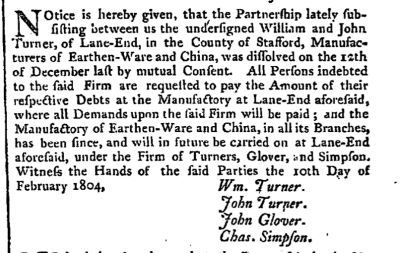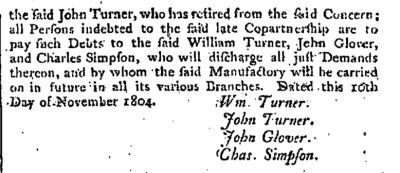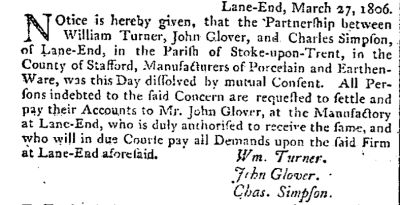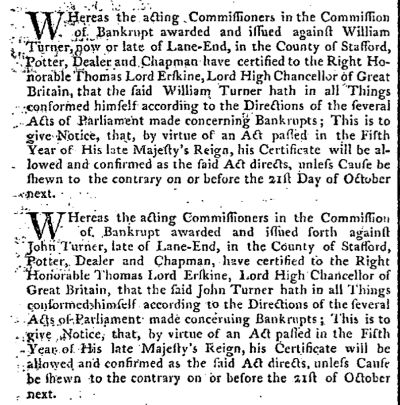![]()
|
John
Turner |
Location and period of operation:
|
John
Turner |
Stoke |
1756 |
1762 |
|
John
Turner |
Lane End |
1762 |
1780 |
|
Turner & Abbot |
Lane End |
c.1781 |
1792 |
|
William
& John
Turner |
Lane End |
1792 |
1804 |
|
Turner & Co |
Lane End |
1804 |
1806 |
|
William
Turner |
Lane End |
1806 |
1829 |
| these date ranges reflect those given by Coysh & Henrywood The Dictionary of Blue & White Printed Pottery 1780-1880. |
Manufacturer of
Earthenware, Cream-ware, Wedgwood-type ware - Jaspers, etc. at Stoke and
then at Lane End (now Longton), Stoke-on-Trent, England.
Useful links: Turner - History of the Staffordshire Potteries, Shaw Turner - Printed British Pottery & Porcelain
|
|
Marks used on ware for identification: 'As a general rule the mark used throughout the life of the firm was simply the impressed name "TURNER", although "TURNER & CO" was used between 1803 and 1806. Several marks after 1784 include the Prince of Wales' Feathers, reflecting the firms appointment as potters to the Prince'. Coysh & Henrywood |
TURNER
TURNER & CO
I TURNER
TURNER'S PATENT
|
TURNER, John (1737-87), pottery manufacturer, Lane End (now called Longton) John Turner of Lane End was christened 7th Jun 1737 at St Nicholas Church, Newport, Shropshire to parents Walter Turner & Mary Phipps. Where he attended school is not known but he was sufficiently well-educated to be able to write his pottery chemical formulae in French to guard against industrial espionage. He was apprenticed to a Staffordshire potter, Daniel Bird, in 1753, and was established by 1756 in a partnership with R. Banks, making white stoneware, in a factory on the site of what became Copeland-Spode, in Stoke upon Trent. He moved to Lane End in 1762. (Jewitt). He was acknowledged as being 'one of the cleverest and most successful potters Staffordshire ever produced.' The earliest dated piece attributed to him is a 1762 teapot. About 1780 he discovered a vein of fine clay, peacock marl, at Green Dock, Edensor (Longton), from which he made a wide variety of ware of a cane colour. He also produced a blue glazed pottery similar to Japanese porcelain. He was both a friend and commercial rival of Josiah Wedgwood. John Turner was one of the six founders of the New Hall Works, Shelton. John Turner was a pioneer of the atmospheric Newcomen steam engine in the Potteries, installing one in his pottery in 1775. He was appointed potter to the Prince of Wales in 1784 and some of the ware is marked with the Prince of Wales feathers. He married Ann nee Emery on 15 October 1759 and by her had three sons and three daughters. His sons William and John later became his partners, continuing the business after his death on 24 December 1787. The firm was declared bankrupt in 1806. William continued on his own until 1829 when the factory was sold.
|
|
TURNER, William (1762-1835), pottery manufacturer, Longton. William Turner was born in1762, the son of John Turner. With his brother John he was in partnership with his father in the works at Lane End (Longton). After John Turner senior's death William and his brother continued the business. On 19 January 1800 they took out a patent for the manufacture of a new kind of stoneware called Turner's patent, which used Tabberner's mine rock. The rights were sold to Spode in 1805. The firm was declared bankrupt in 1806 and William continued on his own until the factory was sold in 1829. The firm's productions were among the best wares of their day, equaling Wedgwood's in quality and sometimes being mistaken for them. William was in Paris during the French Revolution, was arrested and escaped with his life only by the intervention of the British ambassador, the marquis of Stafford (later Duke of Sutherland). The effects of the revolutionary and Napoleonic wars contributed to the firm's financial collapse in 1806. William, a rather more public figure than his brother John, was a major in the Longton volunteers in 1803. His bust, by George Ray, is in Stoke on Trent City Museum. William Turner died in Longton on 5 July 1835.
|
|
1804 and after - Turner & Co:
|
| The
London Gazette 14th February 1804  notice of the dissolution of the partnership between William & John Turner - John Glover and Charles Simpson joined them and the business became Turner, Glover & Simpson |
The
London Gazette 17th November 1804   notice that John Turner retired from the business |
The
London Gazette 1st April 1806  notice of the dissolution of the partnership between William Turner, John Glover and Charles Simpson |
The London Gazette
27th September 1806

notice that William and John
Turner had conformed
to the bankruptcy requirements placed upon them
Questions, comments, contributions? email: Steve Birks